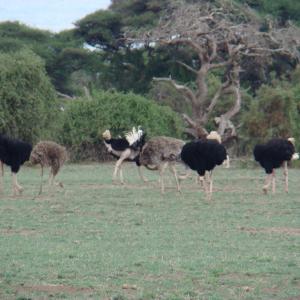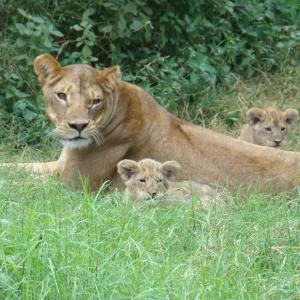“Home of the African Elephant”
Kilimanjaro’s Kingdom, one of Africa Travel’s finest safari destinations
Towered over by the magnificent bulk of 5,896 m high Mount Kilimanjaro, Africa’s highest mountain, Amboseli National Park is one of Kenya’s oldest and most-visited safari parks. Comparatively compact and dotted with emerald green swamps in which great herds of elephants can often be seen half-submerged amongst the papyrus grasses, its panoramic vistas and stunning backdrop have made it a venue revered by Hollywood professionals and amateur safari photographers alike.
Kenya Safari Fact File
Altitude: 1,100-1,200 m above sea level.
Area: 392 sq km.
Location: Kajiado District, Rift Valley Province. The park (Meshanani Gate) is 230km south of Nairobi and lies lose on the Tanzanian border wit the majestic Mount Kilimanjaro in the backdrop.
Distance from Nairobi: 230 km south of Nairobi.
Gazetted: established as a reserve in 1968 and gazetted as a National Park in 1974.
Climate: hot and dry, the park lies in the rain shadow of Mount Kilimanjaro. The Africa travel rainy seasons are usually April/May and November/December.
Vegetation: wildlife safari vegetation includes; semi-arid acacias and grasses with papyrus sledges in the swamp lands.
Animals: wildlife safari animals include: lion, cheetah, leopard, elephant, zebra, hi ppo, spotted and striped hyena, Maasai giraffe, oryx, wildebeest, gerenuk, impala and Grant’s gazelle.
Birds: more than 425 species have been recorded.
Roads: 4WD is recommended, especially during the rainy seasons.
One of Kenya’s oldest and most famous parks
Once part of the Great Southern Game Reserve, Amboseli is one of Kenya’s earliest game sanctuaries; it is also one of her most popular attracting over 200,000 tourists per year. One of Kenya’s best safari destinations, Amboseli offers a unique African safari destination.
Lake Amboseli and the swamps
The park covers part of a Pleistocene era lake basin, now dry. Within this basin is a non-permanent lake known as Lake Amboseli, from which the park takes its name (Amboseli means ‘salt dust’ in Maa, the language of the Maasai). Easily flooded during times of heavy rainfall, the lake is fed by underground streams that flow from Mt Kilimanjaro to rise in a series of lush papyrus Cyperus papyrus swamps. These are surrounded by tracts of Acacia xanthophloea (more commonly known as ‘fever tree’) woodland while open Acacia tortilis woodland also occurs along drainage lines in the southern part of the park. The basin is surrounded by Acacia-commiphora bushland, while the alkaline soils of the lake floor support thickets of Salvadora persica and Suaeda monoica.
During the dry seasons the heat creates a series of shimmering mirages over the lake basin and, because the swamps are the only source of permanent water and the park’s major watering points, they attract large concentrations of wildlife at this time.

What to see
Amboseli is world-famous amongst Africa safari destinations, for its populations of large mammals. The swamps are a centre of activity for elephants, hippos, buffaloes and abundant water birds. The surrounding flat grasslands are home to grazing antelopes. Spotted hyenas are plentiful, as are jackals, warthogs, olive baboons and vervet monkeys.
No longer present in their original numbers, lions can still be found in Amboseli though the famous black-maned lions have long since disappeared, as have the black rhinos that were once so plentiful.
Over 400 bird species
Bird life is abundant, especially in the vicinity of the lakes and swamps where a great variety of water birds may be seen. Over 425 bird species have been recorded here, including over 40 species of birds of prey, amongst which are two great rarities, the Taita falcon and the southern banded harrier eagle. Several species of global conservation concern occur, including lesser kestrel, small numbers of non-breeding Madagascar squacco herons and lesser flamingo in variable numbers. Perhaps the most frequently seen and easily identified of the park’s birds, however, is the aptly named superb starling with its gorgeous iridescent plumage and fearless behavior. Grey-crowned cranes are also frequent visitors to the plains.
Observation Hill
One of the high points of the park and a popular destination for daytime safaris, Observation Hill towers above a small car park and its summit is accessed by a winding stone stairway. Once at the top the views are tremendous, the photo opportunities countless and, as the sun begins its descent, it provides one of East Africa’s finest sundowner venues.
Safari holidays: Accommodation
The park offers a wide selection of safari lodges, national park lodges and tented camps, most of which are regularly featured on the most popular Africa tour, safari travel and family holiday itineraries.
| Economy | AA Lodge |
| Comfort | Kilima Camp, Centrim Camp, Kibo Camp, Amboseli Sopa |
| Luxury | Ol Tukai Lodge, Amboseli Serena, Satao Elerai, Tawi Lodge |


